|
Styling ideas;
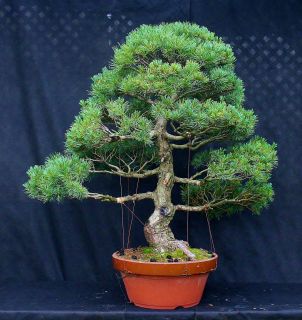
These two trees are both grafted white pines, the tree on the left is typical of an imported piece of raw field grown material ready to be styled as a bonsai. There are plenty of branches left on the tree to work with, and over the years the shoots have been pruned so the branches are well covered with needles and fine growth. The tree is still in a training pot and would be the ideal material for a workshop or progression series. The trunk style is informal upright and the branches could be styled in several ways to make different tree images - it is excelent to find this sort of tree as you can have all the enjoyment of the final creation (and the price is much lower than a styled bonsai to reflect this). I feel the three lowest branches will probably go so the tree takes on a large tree image, then the remaining branches will be swept downwards to reduce the height and width. We'll get onto styling this tree later when we have 24 hours free to wire it! .
Tree two is also a grafted japanese import tree, but this one had recieved several years of refining to build the ramification of the branches and foliage density before leaving Japan. Material like this still needs more styling to refine it into a bonsai so fits in the middle price bracket for a white pine.

This shows the tree as you would find it in a UK bonsai nursery - the graft is quite high on this tree but it works with this design as you dont see the step down to the thinner trunk. I have just removed the 3 year old yellow needles from all the branches (you can see the pile of straw coloured needles in front of the pot).
To critique the material a few obvious things need doing - the main branch is very flat, then it hooks up at the end where it was prunned back. With the powerfull trunk moving to the right this branch does not fit the design at all, so it will be pulled down in two stages.
The rest of the foliage is just one mass, giving no feeling of a tree at all - this solid mass needs turning into smaller pads and I want to show the trunk off some more as it goes up into the canopy. Styling like this does not take very long - about an hour at most, and because the tree had mature foliage already it is a lot further down the route to classing as a pine bonsai
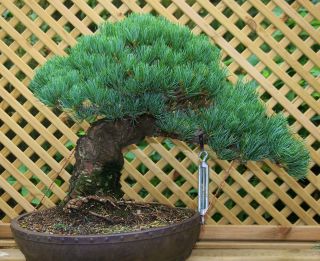
To bend the main branch from close to the trunk I cut underneath it with a saw and pulled the branch down with a fence strainer - these are one of the best tools for bending trunks and branches - and they are a bargain at £2.00 each too! This successfully dropped the branch but the tip still hooked up in the odd manner so a second straining wire (copper) was added further along to pull the tip down.
Compared with the picture above the tree now looks balanced and older - just 10 minutes work produced this change so not all bonsai tecniques are time consuming.
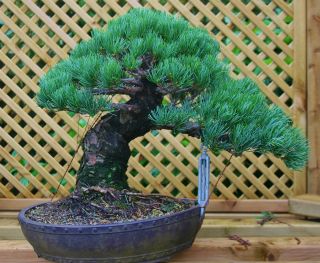
Moving on to the next stage a few forward pointing branches have been removed and others have been spread with wire, so we can see the trunk better. This has also exposed the second curve in the trunk and it is very pleasing to see there is no large drop in diameter between the root stock and grafted foliage. In this picture you can see the mica pot that was used to anchor the wires and tensioner has started to warp due to the very high pressure the branches are under while pulling them into position.
This work was done one afternoon in September and it shows how quickly you can improve any material.
 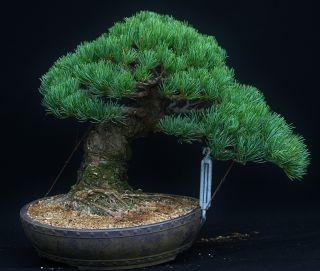
This is only part of the work though - keeping a white pine so dense and healthy needs several special pruning methods over the year. If the tree is healthy and well maintained there will be many branches with 3 or more buds on the ends ready to open in the coming spring. These need reducing to 2 buds so the growth remains even across the tree and the branch tips do not become thick and overcrowded. Here we see a branch tip with 3 buds - a central strong bud and a weaker bud either side.
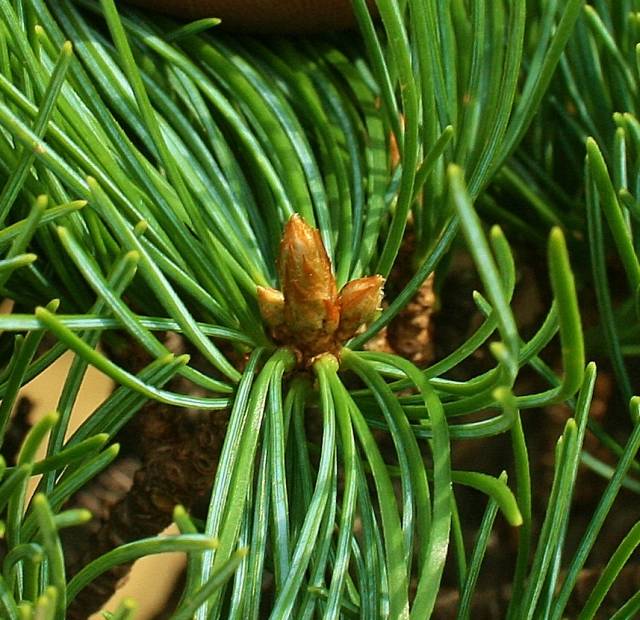
The large bud needs to be removed with tweezers without damaging the side buds - the purpose is to remove the strong central growth and produce equal and weaker growth to either side. This increases ramification while reducing branch thickness and needle size.
Here is the bud removed
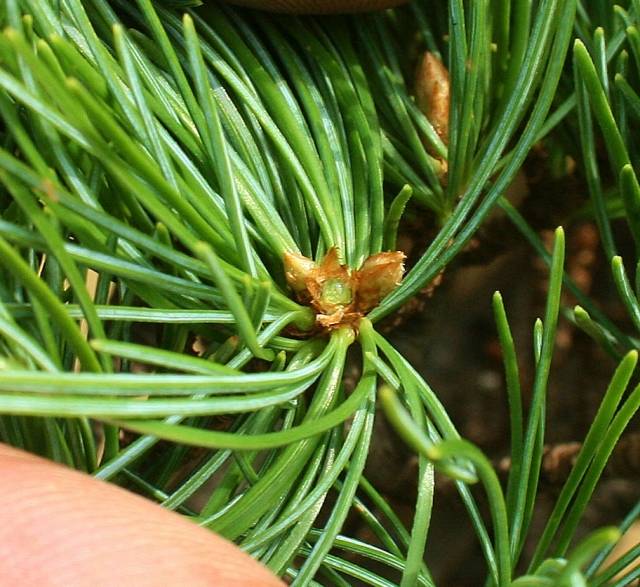
Ramification is the key to creating high quality pine bonsai - wiring will point a branch in the right direction but it is the pruning techniques and timing that give branches a structure like this
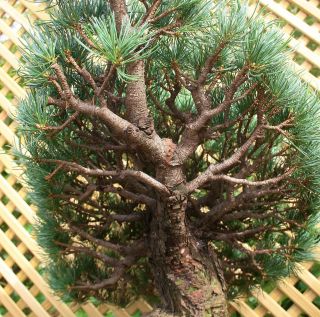
The next pruning work will be spring time so all we do now is protect the pot from excessive rain so it doesnt cause roots to rot. If time allows this winter I will fully wire the foliage to turn the large mass of needles into several pads.
Febuary 2012
I bought the tree into the garage this month and removed any old and discoloured needles. The strainer and guy wires were taken off and some of the very strong shoots cut off, back to a weaker inner shoot.
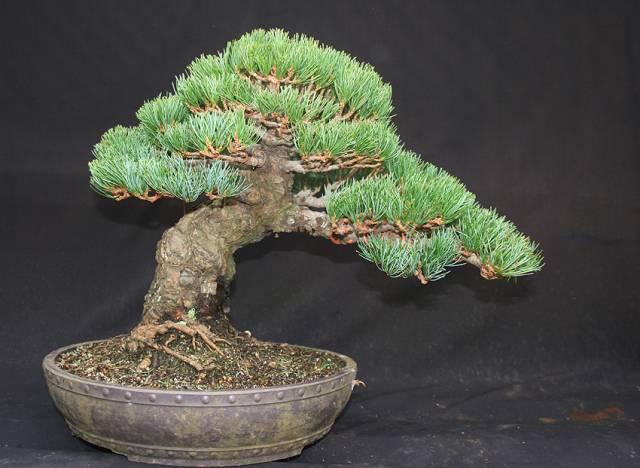
the tree has some space now for the inner buds to recieve light and air, and in a month or so will be repotted into a ceramic pot from the mica it is in at the moment.
Pinus pentaphylla - ungrafted white pine
This tree was nearly ruined when incorrect soil was used - the tree was potted in pure akadama and during 3 wet winters many roots were killed - each spring branches would die off from the bottom until only three remained at the very top of the tree. The tree was replanted in a smaller pot with a high percentage of kiryu grit and some chopped sphagnum moss to promote new root tip growth. I decided to cut the three branches right back to a few inner side shoots so some faulty, previously crossed sections of the branches could be cut away. This really put the tree back to stage 1 but the trunk was good, the bark was forming nicely and the pads could be formed from scratch.
 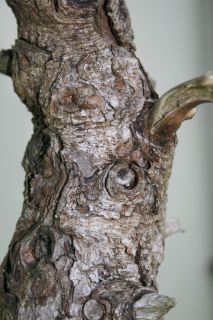 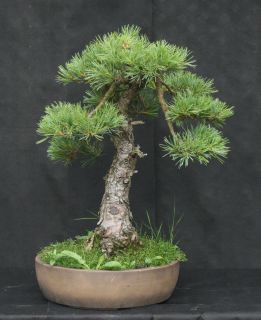
These pictures show the tree 12 months apart and the increase in foliage density is easy to see. In the right hand picture the tree is very dense and bushy as it needs the old needles removing. This tree only had 3 branches all near the top so it is planned to wire up a new leader to continue the trunk line. This extended trunk will hold the crown and the dropping branches will be extended further - This tree shows how easy it is to set a tree back many years through making a mistake - the damage occured about 7 years ago, the tree just hung on sulking for the next 5 years and has only started growing properly again in the last 2 years.
White Pine seasonal care
To balance the energy within the tree
The tree will have strong areas that grow fast and dense, medium areas that maintain average growth and weak areas of sparse thin growth. To be successfull keeping a white pine bonsai the energy must be balanced between the areas so growth is equal across the tree - firstly you need to identify the areas on your tree -
strong zones are the upper branches and often some outer branch tips
medium zones tend to be the middle branches and branches inside the strong zone
weak areas are the lowest branches and tiny weak shoots in the inner areas of the tree
firstly observe the tree - the zones are visible from the density and amount of needles on the tree and the length of the extended growth. You will get a second time to observe the 3 areas in the spring when the buds elongate to form the candles *
*candles are the tight cylindrical lengthening buds that the needles will emerge from.
April / May - time to pinch candles
As the tree breaks winter dormancy the buds with start growing longer, forming 'candles'. The strong candles will be getting longer than the others on the tree as they are taking all the energy - so these must be shortened first to stop their development and to let the energy travel to weaker parts of the tree. it is best to pinch off half of the length of these candles with your finger tips if you can but you must not totally remove the candle as the branch could weaken or die completely. If you feel unsure of pinching wait a few more weeks until the new needles are popping out and cut off half of the length with fine sharp scissors.
This job has shortened the strong growth first and by the most, directing energy to the other zones. This job must be done every single year you own the tree, otherwise the tree will revert and the hard work undone.
June / July - pruning shoots
Summer pruning is needed on the white pine to promote budding and to maintain the shape of your design, (other than a branch you wish to extend longer). It is important to understand the pinching is to balance energy and that pruning is still needed to shape and develop the tree. Strong and medium areas that were pinched earlier in the year will still have extended into shoots and some of these will need to be shortened to keep desired branch lines, other strong shoots that are growing beyond the design you want can be removed back to an inner shoot as long as there are buds and needles on the inner shoot.
Use sharp scissors to cut the shoots, always cut squarely across the shoot, not at an angle, and make sure at least 4 or 5 sheaths of needles (20-25 actual needles) remain on the shoot. Do not over prune a white pine in one area as the entire branch will weaken and could die
** the ungrafted pine is already a weaker tree so, while pinching remains the same I have found pruning needs to be a little more gentle - best to leave 6-7 sheaths of needles in all areas and again, do not prune the weak growth**
September / October - Needle removal
Now we need to remove old needles from the tree - if you've just started the tree it will have up to 3 years of needles in place so remove the 3yrs old ones (thery will be straw yellow colour) and any other needles that are yellowing, discoloured or marked with bands. White pine bonsai stay stronger and healthier if all green needles are left on the shoots
Winter Care and protection
You will kill a white pine with too much kindness - The tree is cold hardy down to about -17 without too much worry as long as you use the correct soil, and absolutely make sure the soil is not too wet before the cold weather hits. If you read up on the taxonomy of the white pine it is a clear fact the tree needs at least 8 weeks below zero for its ongoing health, and this is the key point - bonsai techniques work on healthy trees while they can kill weak trees, so before contemplating wiring, root pruning, carving etc the tree needs to be totally healthy.
Exposure is the key - in summer they need to be on the sunny exposed benches not tucked under shade netting and in the winter they want to be cold and even frozen in the pot - so not indoors, not in a heated greenhouse etc. If you need to keep the tree dry sitting the tree on the floor of a cold greenhouse will still get it cold enough while keeping the rain off. I keep white pines very cold & dry, Black pines more protected from cold (and dry), and scots pines just left on the bench in rain and cold !
Any of you living around the coast of Cornwall could struggle with white pines as we are global climate zone 9b, which is actually outside the trees required zone so you may not get cold enough in the garden. Dont loose heart, either lend them to one of the inland members for the winter or get a black pine instead.
Wiring and feeding
This guide will enable a white pine bonsai to be developed and maintained with healthy dense growth. Going hand in hand with this you may want to wire the tree and a white pine can be wired in any month, but a newly wired tree is better protected from hard frost. I will leave wire in place for a year but will check fine wires in strong zones after 6 months in case it is biting in.
Feeding depends on the stage your tree is at:
For a young tree needing lots of growth i'd feed from May to Oct with dry pelleted fertilisers like Naruko or these days my own blended rape seed cakes. Twice in this time i'd mix a bath of miracle acid and submerge the pots in it to acidify the soil.
A semi trained tree will be fed july to sept, this will give slightly longer needles but lots of strength and plenty of buds to work with, so ramification will be achieved quicker. I would avoid naruko and concentrate in a good feed of a cake type feed, with occasional liquid feeds too.
If you have a fully trained tree you can feed it to just maintain image and outline..........a japanese nursery method is to not feed until early September, then remove the feed cakes by mid October- the tree will absorb enough food ready for the new spring growth but not so much that new growth becomes too course and strong.
Due to the soil mixtures used feeding is essential - there is no plant nutrition in akadama or kiryu so a tree will weaken and waste away if not fed properly - do not skip this important part of keeping a pine bonsai healthy.
|